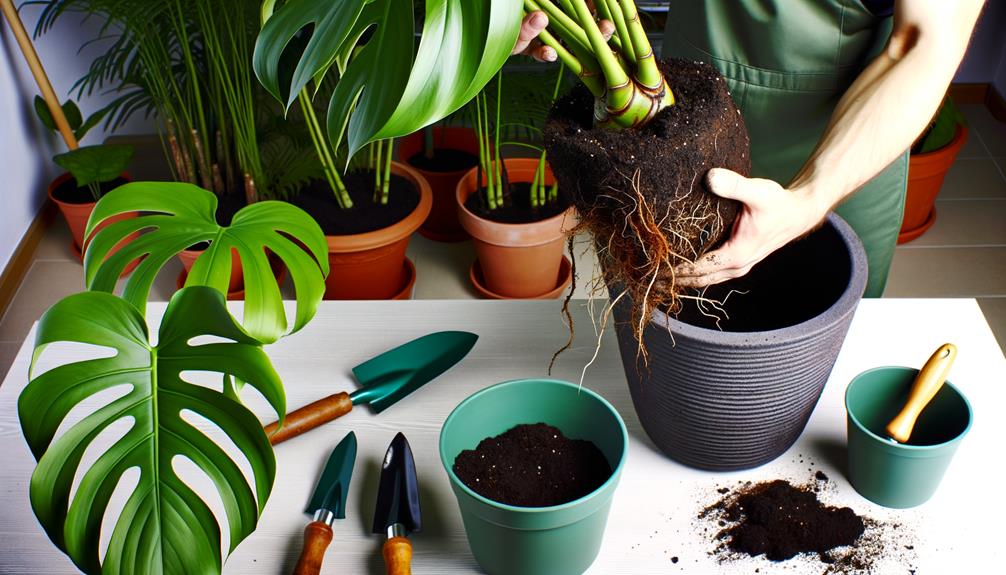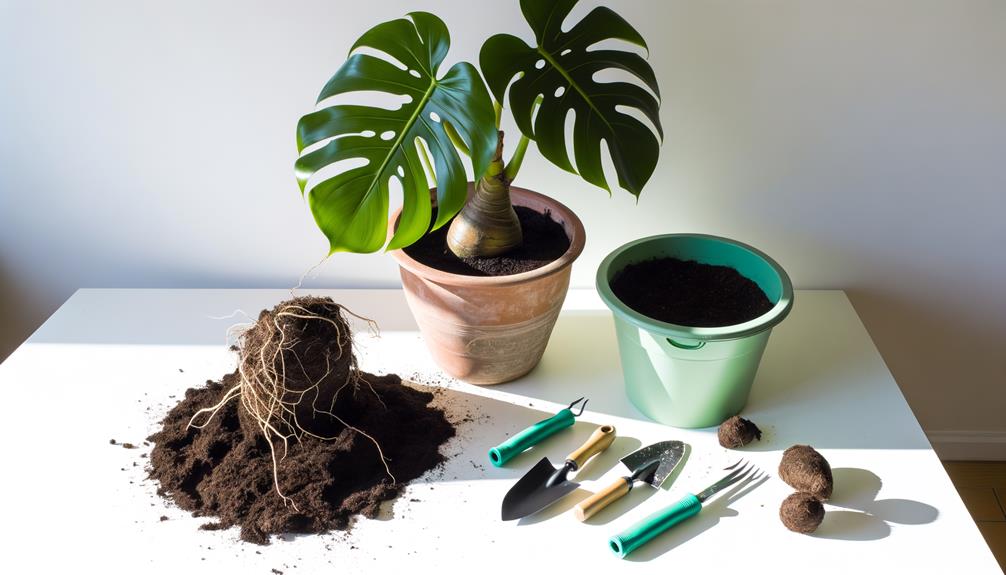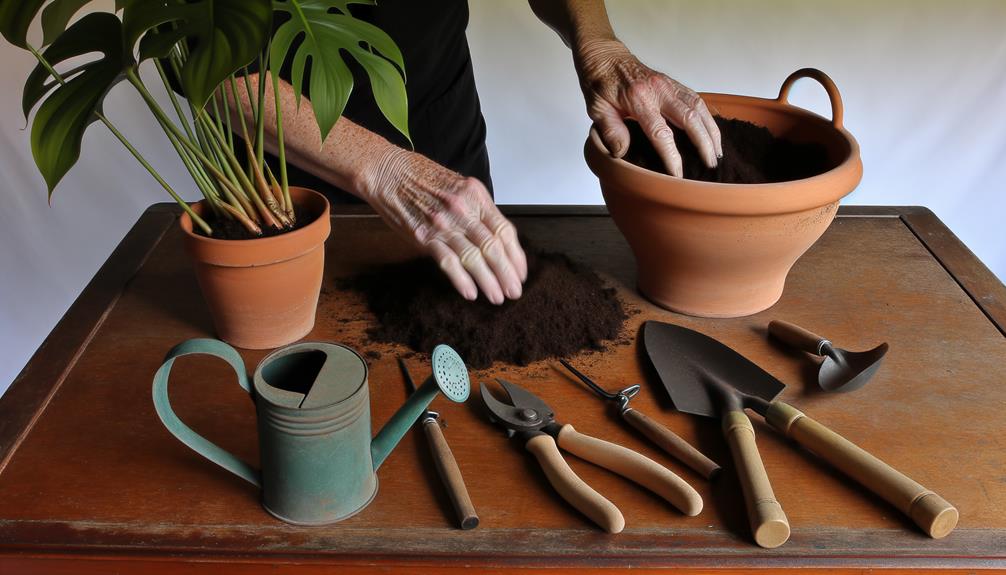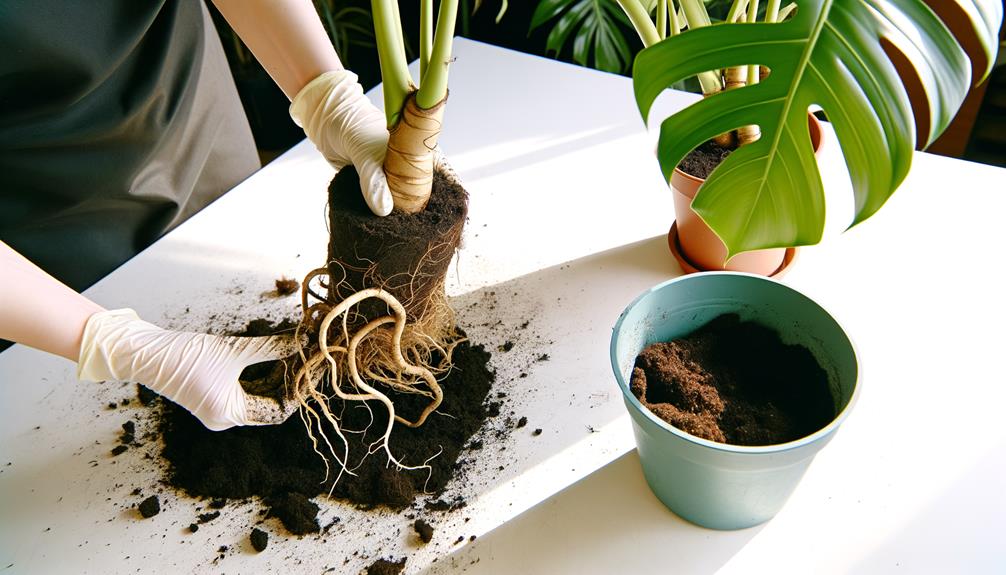How to Repot Monstera Deliciosa
Repot your Monstera Deliciosa when roots emerge from drainage holes or soil becomes compacted. Use sterilized tools, a new pot 2-4 inches larger, and a well-draining mix of peat moss, pine bark, and perlite.
Remove the plant carefully, inspect and trim damaged roots. Position it centrally in the new pot, add soil, and press firmly to remove air pockets.
Water thoroughly to settle the soil. Place the plant in bright, indirect light, maintain a watering schedule, and monitor humidity levels.
For detailed insights into each step and thorough post-repotting care, continue exploring the extensive guide.

Key Takeaways
- Choose a pot 2-4 inches larger in diameter with multiple drainage holes.
- Use a well-draining potting mix containing perlite, peat moss, and pine bark.
- Gently remove the plant, inspect, and trim any damaged roots.
- Position the plant centrally, fill with soil, and press gently to eliminate air pockets.
- Water thoroughly and place in bright, indirect light with 60-70% humidity.
When to Repot

Determining the best timing to repot Monstera deliciosa involves evaluating specific indicators of root growth, soil degradation, and overall plant health.
Primarily, examine the root system; roots protruding from drainage holes signify the requirement for a larger pot.
Next, assess the soil condition—compacted, waterlogged, or nutrient-depleted soil necessitates immediate action.
Additionally, observe the plant's robustness; stunted growth or yellowing leaves may indicate root-bound stress.
Repotting is ideally performed during the plant's active growth phase in spring or early summer to minimize transplant shock.
A systematic approach guarantees the plant's continued health and vigorous growth, optimizing its aesthetic and structural development in a new, adequately sized container with fresh, nutrient-rich soil.
Gather Your Supplies
To guarantee a successful repotting process for your Monstera Deliciosa, follow these steps:
Start by gathering the necessary potting tools, which include a trowel, pruning shears, and gloves.
Next, choose an appropriate pot that allows for sufficient drainage and is slightly larger than the current one.
Necessary Potting Tools
Gathering the appropriate potting tools is crucial for successfully repotting a Monstera Deliciosa and safeguarding its continued health and growth.
Begin with a sturdy pair of gardening gloves to shield your hands from potential irritants and a small trowel for precise soil manipulation.
A clean, sharp pair of pruning shears is necessary for trimming damaged roots and foliage.
A large, shallow tray can help manage soil spillage during the repotting process.
Additionally, use a watering can with a fine rose to provide gentle moisture after repotting.
A stake or trellis may be required to support the plant's climbing nature.
Soil and Pot Selection
Selecting the right soil and pot is essential to guarantee optimal growth conditions for your Monstera Deliciosa. Opt for a well-draining potting mix, preferably one made up of peat moss, pine bark, and perlite. This combination offers aeration and retains essential moisture while preventing waterlogging.
The selected pot should have drainage holes to aid in excess water drainage, averting root rot. Choose a pot that is 1-2 inches larger in diameter than the current one to allow space for growth. Terracotta pots are preferred for their breathability, which promotes root health.
Ensure all materials are sterilized to reduce the risk of introducing pathogens. Sufficient preparation will establish a solid foundation for the flourishing of your Monstera Deliciosa.
Prepare the New Pot

When preparing the new pot for your Monstera Deliciosa, it is crucial to select an appropriately sized container that accommodates the plant's growth.
Verify the pot has sufficient drainage holes to prevent waterlogging, which can lead to root rot.
Additionally, consider using a well-draining potting mix to support the plant's health and vigor.
Select Proper Size
Choosing the correct pot size is vital for the healthy growth of Monstera Deliciosa, as it guarantees sufficient space for root expansion and proper drainage. An undersized pot can restrict root growth, leading to stunted development, while an oversized pot may retain excessive moisture, risking root rot. Ideally, select a pot 2-4 inches larger in diameter than the current one to allow gradual, healthy growth. Below is a guideline to help in selecting the appropriate pot size:
| Current Pot Size (Diameter) | Recommended New Pot Size (Diameter) |
|---|---|
| 6 inches | 8-10 inches |
| 8 inches | 10-12 inches |
| 10 inches | 12-14 inches |
| 12 inches | 14-16 inches |
| 14 inches | 16-18 inches |
This approach guarantees the plant has ample room for root expansion without compromising soil moisture balance.
Ensure Good Drainage
Ensuring good drainage is vital to prevent waterlogging, which can lead to root rot and other health issues in Monstera Deliciosa. Begin by selecting a pot with multiple drainage holes. These facilitate the rapid expulsion of excess water, hence maintaining ideal soil moisture levels.
Furthermore, line the bottom of the pot with a layer of coarse material, such as gravel, pebbles, or broken pottery shards. This layer acts as an intermediary, preventing soil from obstructing the drainage holes.
Additionally, choose a well-draining potting mix, ideally comprising components like perlite, orchid bark, and peat moss. This combination ensures aeration and prevents compaction, thereby enhancing root health.
Proper drainage setup is essential for sustaining the plant's overall well-being.
Remove the Monstera
To start the removal process, gently loosen the soil around the base of the Monstera Deliciosa to minimize root damage. Utilize a small trowel or your fingers to carefully work the soil free, making sure not to break or disturb the roots excessively.
Next, follow these steps to complete the removal:
- Tilt the pot: Slightly angle the pot to facilitate easier extraction of the plant.
- Support the base: Hold the plant at its base, close to the soil line, to provide stability.
- Lift gently: Carefully lift the plant from the pot, ensuring rootball integrity.
- Inspect roots: Examine the roots for signs of rot or damage, trimming any unhealthy sections with sterilized scissors.
This method guarantees a smooth handover without compromising plant health.
Repotting Process

Before placing the Monstera Deliciosa into its new pot, make certain the container is appropriately sized and filled with a well-draining soil mix to promote healthy root growth.
Begin by gently holding the base of the plant to position it centrally within the pot. Gradually add soil around the roots, making sure it fills any gaps while maintaining the plant's vertical alignment. Firmly press the soil down to eliminate air pockets, but avoid over-compacting.
Continue adding soil until it reaches approximately one inch below the pot's rim. Water the plant thoroughly to help settle the soil and encourage root establishment. Ensure excess water drains out to prevent root rot.
This systematic approach fosters ideal growth conditions for your Monstera Deliciosa.
Post-Repotting Care
Post-repotting care is essential for the successful acclimation and continued health of your Monstera Deliciosa. Following the repotting procedure, attention to several critical aspects will guarantee the plant thrives in its new environment.
- Watering: Immediately water the plant to settle the soil. Subsequently, maintain a consistent watering schedule, allowing the top inch of soil to dry out between waterings.
- Light: Position the plant in bright, indirect light. Avoid direct sunlight, which can stress the freshly repotted Monstera.
- Humidity: Maintain a humidity level of 60-70%. Use a humidifier or mist the leaves regularly to replicate its natural tropical habitat.
- Observation: Monitor the plant for signs of stress, such as yellowing leaves or wilting, and adjust care routines accordingly.
These steps will facilitate a smooth adjustment and promote vigorous growth.
Conclusion
Repotting a Monstera deliciosa demands both precision and care, contrasting the technical aspect of the procedure with the natural charm of the plant.
The detailed steps of preparation and execution emphasize the fragile equilibrium required for successful transplantation. This systematic approach guarantees the Monstera flourishes, evolving from a restricted condition to one of rejuvenated growth and importance.
Therefore, the painstaking effort dedicated to repotting yields not only a healthier plant but also a deeper connection to nature's intricate processes.






